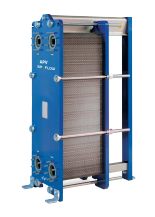AxFlow are the exclusive supplier of APV heat exchangers



Plate Heat Exchangers
3 series from 1 manufacturers
Plate heat exchangers work by transferring heat between two fluids that flow on opposite sides of metal plates. The hot and cold fluids pass through separate channels, with the plates acting as the interface for heat exchange. The corrugated design of the plates enhances turbulence, increasing heat transfer efficiency. The fluids can flow in either counter-current or parallel arrangements, but counter-current flow is more efficient as it maximizes the temperature difference. Gaskets between the plates prevent fluid mixing, and by controlling the flow rates, the heat transfer rate and temperature difference can be adjusted. The compact design and large surface area of the plates make plate heat exchangers efficient and widely used in various industries.
Why buy plate heat exchnagers from axflow
AxFlow supply APV plate heat exchangers, APV plate heat exchangers are designed with advanced technology and optimized plate patterns to maximize heat transfer efficiency. Aswell as this APV Plate heat exchangers are available in various plate types, sizes and configurations, thus making them highly versatile and suitable for a range of applications.
Where can Plate heat exchangers be used:
-
Chemical Processing: In various chemical processes, plate heat exchangers play a crucial role in heating, cooling, and condensing fluids, contributing to process efficiency and energy savings.
-
Food and Beverage Industry: Plate heat exchangers are used for pasteurization, heating, and cooling applications in the food and beverage production, preserving product quality and safety.
-
Marine industry: Plate heat exchangers are employed in marine vessels for various cooling and heating purposes, including engine cooling, HVAC, and desalination.
-
Oil and Gas Industry: Plate heat exchangers are used in the oil and gas sector for various processes, such as crude oil cooling, natural gas processing, and heat recovery.
-
Pharmaceutical Industry: Plate heat exchangers are utilized for heating and cooling in pharmaceutical manufacturing processes, where precise temperature control is critical.
Benefits of using Plate heat exchangers:
-
Efficient Heat Transfer: Plate heat exchangers are highly efficient in transferring heat between two fluids due to their design. The thin metal plates create a large surface area, allowing for more effective heat exchange. The corrugated patterns on the plates promote turbulence, further enhancing heat transfer rates. As a result, plate heat exchangers require less energy to achieve the desired temperature changes, leading to cost savings and reduced environmental impact.
-
Compact Design: Plate heat exchangers have a compact and space-saving design compared to traditional shell-and-tube heat exchangers. The stacked plate arrangement provides a high surface area-to-volume ratio, making them ideal for applications with limited space. The compactness also contributes to faster startup times, as the unit reaches the required operating temperature quickly.
-
Easy Maintenance and Cleaning: Plate heat exchangers are designed for easy disassembly, making maintenance and cleaning straightforward. The smooth surfaces of the plates reduce the risk of fouling and scaling, but when needed, the plates can be removed and cleaned with relative ease. This feature ensures better system performance and prolongs the heat exchanger's lifespan, reducing downtime and maintenance costs.


